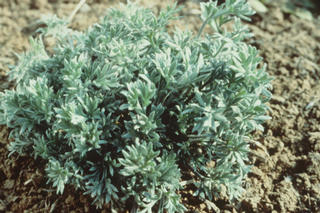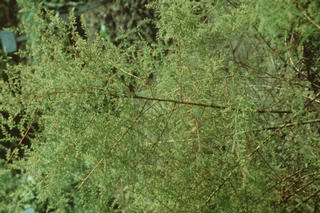Artemisia capillaris
Contents
- 1 Nomenclature
- 2 Historical Use of Artemisia capillaris
- 3 Background
- 4 Nomenclature
- 5 Historical Use of Artemisia capillaris
- 6 Background
- 7 Nomenclature
- 8 Historical Use of Artemisia capillaris
- 9 Background
- 10 Nomenclature
- 11 Historical Use of Artemisia capillaris
- 12 Background
- 13 Pharmaceutical Information
- 14 Evidence or the Use of Artemisia capillaris in the Treatment of Epilepesy
- 15 Safety
Nomenclature
Other Names:
Historical Use of Artemisia capillaris
Artemisia capillaris in Traditional Chinese Medicine
Background
Chinese Name (pinyin): Yinchen (Yinchenhao)
Chinese Name :
Common Name :Oriental Wormwood
Specific Name : Herba artemisiae scopariae
Scientific Name:
Collection : The drug is collected in spring when seedling is 6 - 10cm high, or in autumn when the bud is forming, remove from foreign matter and older stem and dried in the sun. The drug collected in spring is known as "Mianyinchen" and that collected in autumn is known as "Yinchenhao".
Description : Mianyinchen: mostly rolled into masses, greyish white or greyish green, densely covered with white pubescences throughout, soft like a nap. Stems thin and small. 1.5 - 2.5cm long, 1 - 2mm in diameter, longitudinal striations distinct after removing the white pubescences on the surface, texture fragile and easily broken. Leaves petioled when whole, 1 - 3 pinnatipartisect, lumina 1 - 3nm long, about 1cm wide. Segments ovoid or slightly oblanceolate, strip shaped, apex acute, odor delicately aromatic and taste slightly bitter.Yinchenhao: Stems cylindrical, frequently branched, 30 - 100cm long, 2 - 8mm in diameter, externally pale purple or purple, striated longitudinally, pubescent, light. Texture fragile, fracture whitish, leaves densely gathered or mostly fallen off. Basal leaves 2 - 3 pinnatipartite, segments stripe shaped or finely stripe shaped, densely covered with white pubescences on both surfaces, cauline leaves 1 - 2 pinnatipartisect, amplexicaul at the base, segments filamentous, capitulum ovoid, mostly gathered into conical. 1.2 - 1.5mm long, 1 - 1.2 mm in diameter, short petioled, involucres 3 - 4 layers, ovoid, bracts 4-lobed, the outer female flowers 6 - 10 up to 15, the inner bisexual flowers 2 - 10, achenes oblong, yellowish brown. Odour aromatic, taste slightly bitter.
Identification :
Processing : Eliminate remains of roots and the foreign matter, rub or cut into pieces. For Mianyinchen, sift to remove dust.
Action : To remove damp-heat and relieve jaundice.
Indication : infectious icteric hepatitis; sores with exudation and itching
Precautions :
Dosage : 6 to 15 g; for external use, appropriate quantity to be made into hot decoction for fuming and washing.
Storage : Preserve in a cool and dry place, protected from moisture.
Nomenclature
Other Names:
Historical Use of Artemisia capillaris
Artemisia capillaris in Traditional Chinese Medicine
Background
Chinese Name (pinyin): Yinchen (Yinchenhao)
Chinese Name :
Common Name :Oriental Wormwood
Specific Name : Herba artemisiae scopariae
Scientific Name:
Collection : The drug is collected in spring when seedling is 6 - 10cm high, or in autumn when the bud is forming, remove from foreign matter and older stem and dried in the sun. The drug collected in spring is known as "Mianyinchen" and that collected in autumn is known as "Yinchenhao".
Description : Mianyinchen: mostly rolled into masses, greyish white or greyish green, densely covered with white pubescences throughout, soft like a nap. Stems thin and small. 1.5 - 2.5cm long, 1 - 2mm in diameter, longitudinal striations distinct after removing the white pubescences on the surface, texture fragile and easily broken. Leaves petioled when whole, 1 - 3 pinnatipartisect, lumina 1 - 3nm long, about 1cm wide. Segments ovoid or slightly oblanceolate, strip shaped, apex acute, odor delicately aromatic and taste slightly bitter.Yinchenhao: Stems cylindrical, frequently branched, 30 - 100cm long, 2 - 8mm in diameter, externally pale purple or purple, striated longitudinally, pubescent, light. Texture fragile, fracture whitish, leaves densely gathered or mostly fallen off. Basal leaves 2 - 3 pinnatipartite, segments stripe shaped or finely stripe shaped, densely covered with white pubescences on both surfaces, cauline leaves 1 - 2 pinnatipartisect, amplexicaul at the base, segments filamentous, capitulum ovoid, mostly gathered into conical. 1.2 - 1.5mm long, 1 - 1.2 mm in diameter, short petioled, involucres 3 - 4 layers, ovoid, bracts 4-lobed, the outer female flowers 6 - 10 up to 15, the inner bisexual flowers 2 - 10, achenes oblong, yellowish brown. Odour aromatic, taste slightly bitter.
Identification :
Processing : Eliminate remains of roots and the foreign matter, rub or cut into pieces. For Mianyinchen, sift to remove dust.
Action : To remove damp-heat and relieve jaundice.
Indication : infectious icteric hepatitis; sores with exudation and itching
Precautions :
Dosage : 6 to 15 g; for external use, appropriate quantity to be made into hot decoction for fuming and washing.
Storage : Preserve in a cool and dry place, protected from moisture.
Nomenclature
Other Names:
Historical Use of Artemisia capillaris
Artemisia capillaris in Traditional Chinese Medicine
Background
Chinese Name (pinyin): Yinchen (Yinchenhao)
Chinese Name :
Common Name :Oriental Wormwood
Specific Name : Herba artemisiae scopariae
Scientific Name:
Collection : The drug is collected in spring when seedling is 6 - 10cm high, or in autumn when the bud is forming, remove from foreign matter and older stem and dried in the sun. The drug collected in spring is known as "Mianyinchen" and that collected in autumn is known as "Yinchenhao".
Description : Mianyinchen: mostly rolled into masses, greyish white or greyish green, densely covered with white pubescences throughout, soft like a nap. Stems thin and small. 1.5 - 2.5cm long, 1 - 2mm in diameter, longitudinal striations distinct after removing the white pubescences on the surface, texture fragile and easily broken. Leaves petioled when whole, 1 - 3 pinnatipartisect, lumina 1 - 3nm long, about 1cm wide. Segments ovoid or slightly oblanceolate, strip shaped, apex acute, odor delicately aromatic and taste slightly bitter.Yinchenhao: Stems cylindrical, frequently branched, 30 - 100cm long, 2 - 8mm in diameter, externally pale purple or purple, striated longitudinally, pubescent, light. Texture fragile, fracture whitish, leaves densely gathered or mostly fallen off. Basal leaves 2 - 3 pinnatipartite, segments stripe shaped or finely stripe shaped, densely covered with white pubescences on both surfaces, cauline leaves 1 - 2 pinnatipartisect, amplexicaul at the base, segments filamentous, capitulum ovoid, mostly gathered into conical. 1.2 - 1.5mm long, 1 - 1.2 mm in diameter, short petioled, involucres 3 - 4 layers, ovoid, bracts 4-lobed, the outer female flowers 6 - 10 up to 15, the inner bisexual flowers 2 - 10, achenes oblong, yellowish brown. Odour aromatic, taste slightly bitter.
Identification :
Processing : Eliminate remains of roots and the foreign matter, rub or cut into pieces. For Mianyinchen, sift to remove dust.
Action : To remove damp-heat and relieve jaundice.
Indication : infectious icteric hepatitis; sores with exudation and itching
Precautions :
Dosage : 6 to 15 g; for external use, appropriate quantity to be made into hot decoction for fuming and washing.
Storage : Preserve in a cool and dry place, protected from moisture.
Nomenclature
Other Names:
Historical Use of Artemisia capillaris
Artemisia capillaris in Traditional Chinese Medicine
Background
Chinese Name (pinyin): Yinchen (Yinchenhao)
Chinese Name :
Common Name :Oriental Wormwood
Specific Name : Herba artemisiae scopariae
Scientific Name:
Collection : The drug is collected in spring when seedling is 6 - 10cm high, or in autumn when the bud is forming, remove from foreign matter and older stem and dried in the sun. The drug collected in spring is known as "Mianyinchen" and that collected in autumn is known as "Yinchenhao".
Description : Mianyinchen: mostly rolled into masses, greyish white or greyish green, densely covered with white pubescences throughout, soft like a nap. Stems thin and small. 1.5 - 2.5cm long, 1 - 2mm in diameter, longitudinal striations distinct after removing the white pubescences on the surface, texture fragile and easily broken. Leaves petioled when whole, 1 - 3 pinnatipartisect, lumina 1 - 3nm long, about 1cm wide. Segments ovoid or slightly oblanceolate, strip shaped, apex acute, odor delicately aromatic and taste slightly bitter.Yinchenhao: Stems cylindrical, frequently branched, 30 - 100cm long, 2 - 8mm in diameter, externally pale purple or purple, striated longitudinally, pubescent, light. Texture fragile, fracture whitish, leaves densely gathered or mostly fallen off. Basal leaves 2 - 3 pinnatipartite, segments stripe shaped or finely stripe shaped, densely covered with white pubescences on both surfaces, cauline leaves 1 - 2 pinnatipartisect, amplexicaul at the base, segments filamentous, capitulum ovoid, mostly gathered into conical. 1.2 - 1.5mm long, 1 - 1.2 mm in diameter, short petioled, involucres 3 - 4 layers, ovoid, bracts 4-lobed, the outer female flowers 6 - 10 up to 15, the inner bisexual flowers 2 - 10, achenes oblong, yellowish brown. Odour aromatic, taste slightly bitter.
Identification :
Processing : Eliminate remains of roots and the foreign matter, rub or cut into pieces. For Mianyinchen, sift to remove dust.
Action : To remove damp-heat and relieve jaundice.
Indication : infectious icteric hepatitis; sores with exudation and itching
Precautions :
Dosage : 6 to 15 g; for external use, appropriate quantity to be made into hot decoction for fuming and washing.
Storage : Preserve in a cool and dry place, protected from moisture.
Synonymns for Artemisia capillaris
Patent Medicines and Medicines with Multiple Ingredients that include Artemisia capillaris
Pharmaceutical Information
Chemical Constituents
Evidence or the Use of Artemisia capillaris in the Treatment of Epilepesy
Basic Science
Animal Studies
Cohort, Case-Control and Non-Randomized Trials
Randomized Controlled Trials
Meta-Analysis
1st Five Results: pubmed search
Silvano S Twinomujuni, Esther C Atukunda, Jackson K Mukonzo, Musinguzi Nicholas, Felicitas Roelofsen, Patrick E Ogwang
Evaluation of the effects of Artemisia Annua L. and Moringa Oleifera Lam. on CD4 count and viral load among PLWH on ART at Mbarara Regional Referral Hospital: a double-blind randomized controlled clinical trial.
AIDS Res Ther: 2024, 21(1);22
[PubMed:38627722]
[WorldCat.org]
[DOI]
(I e)
Siti Hamidatul Aliyah, Rizky Yulion, Santi Perawati
##Title##
J Exp Pharmacol: 2024, 16;173-174
[PubMed:38623271]
[WorldCat.org]
[DOI]
(P e)
Meng-Yue Wang, Hui-Hua Wan, Li Xiang, Yu-Ting Pu, Qing-Gang Yin, Ran-Ran Gao, Yu-Hua Shi, Lan Wu
[Simultaneous determination of seven artemisinin-related compounds in Artemisia annua by UPLC-QQQ-MS/MS].
Zhongguo Zhong Yao Za Zhi: 2024, 49(5);1260-1265
[PubMed:38621973]
[WorldCat.org]
[DOI]
(P p)
Nadia Hezil, Djamila Baazize-Ammi, Amine Abdelli, Amel Adel, Seddik Kebbal, Ismail Gharbi, Rhéda Djezzar, Djamel Guetarni
##Title##
Avian Pathol: 2024;1-27
[PubMed:38616734]
[WorldCat.org]
[DOI]
(I a)
Hyung-Mun Yun, Hyun Sook Kwon, Joon Yeop Lee, Kyung-Ran Park
Vitexicarpin Induces Apoptosis and Inhibits Metastatic Properties via the AKT-PRAS40 Pathway in Human Osteosarcoma.
Int J Mol Sci: 2024, 25(7);
[PubMed:38612399]
[WorldCat.org]
[DOI]
(I e)

